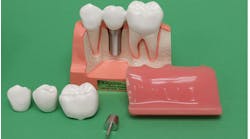Patients can be challenging. They know they need your services, but they may not be ready to commit to the treatment you recommend. Fortunately, you can teach your team to increase case acceptance by asking the right questions, building an emotional connection, and making it easy for patients to afford the treatment they need.
Create a positive impression
Potential patients are forming an opinion of you before they even walk through your door. They may have seen an ad for your practice, found you through Google search, or been referred by someone they trust. Perhaps it was learning more about your practice through a live chat on your website that convinced them to schedule an appointment, or the excellent reviews they read online. Something inspired them to choose you instead of a competitor.
Creating a favorable impression before an appointment will reduce no-shows. Identify your biggest cases for the next day and personally make a quick call to the patients to say, “I have the time reserved for you and I look forward to seeing you.” Most of the time you’ll reach voicemail, and that’s fine. The goal is to impress people with your customer service and to start developing relationships.
Build value through emotional connection
People want to do business with people they know and like. Patients will judge their visits based on their interactions with every team member, not just the dentist. They’ll notice if you asked about their day and seemed friendly, caring, and compassionate.
Some great questions to ask are:
- What brings you in today?
- How is that problem affecting you?
- Is this impacting your ability to eat what you like?
- Does the problem make you feel self-conscious?
- Have you talked to another doctor about this?
- How do you want to feel once we fix the problem?
Then restate what the patient shared with you about the symptoms, concerns, and desired outcome. This will show you were listening closely and reinforces an emotional connection.
Read related content:
How digital treatment planning can increase case acceptance
Practice production, prioritized: Hygiene productivity
Present information according to personality
Every patient is different, but they tend to fall into four personality types. By identifying a patient’s personality, you can predict how they will react to the information you share, and this will increase the likelihood they’ll agree to treatment.
Type A personality: This type of patient is results-oriented and appreciates promptness, efficiency, and quickly getting to the point. The key to converting this type of patient is to focus on the bottom line, not on a lot of details. Project confidence in your treatment plan and highlight the option that will generate the desired results the quickest. Frame the conversation by saying, “I want to respect your time while making sure I answer all your questions.”
Friendly, outgoing personality: Extroverts value relationships deeply and will be more likely to accept treatment from somebody they like and trust. The best way to present treatment is to stay friendly and warm, and to give the patient your full attention. Nod to show you’re listening and ask follow-up questions. Show that you relate to their situation by saying, “I completely understand,” or “I helped a gentleman who had the same issue and here’s how we solved it.”
Quiet and shy personality: Most people are quiet, reserved, or nervous when they come into the dental practice. Using a gentle tone, simple language, and reassuring words will increase their confidence in accepting treatment. Let them know they came to the right place and tell them what they’re going through is common. It’s very likely the patient may need a follow-up call from the clinician to say, “I was thinking about our conversation today and I wanted to see if you thought of any questions for me after you left. I know we can help you have the smile you want.”
Inquisitive, detail-oriented personality: This personality type asks a lot of questions, takes up a lot of time, and does not commit quickly. The best way to convince this person to move forward is to be patient, persistent, and diplomatic. Focus on facts, present patient education materials, and redirect the conversation toward treatment acceptance by saying, “We’ll go over each step when you start treatment. Is there anything else you need to know today about how this treatment will accomplish your goal of a healthier smile?”
Overcome concerns about cost
It’s normal for patients to be concerned about cost. It’s your job to let them know they’re getting an incredible value, that you stand by your work, and that the investment will be completely worth it. Acknowledge their concern and provide solutions. For example, you can say, “I completely understand. Fortunately, we have a lot of options to help people fit the cost of care into their family budget. We even have monthly payment plans available. Let’s look at what will restore your smile and give you the quality of life you want.”
If your practice doesn’t offer payment plans, consider switching to a payment processing service that makes it easy to offer plans. Look for a service that has built-in soft credit checks, customized down payment and monthly installments, tokenized card numbers to keep them securely on file, and automatic card update information.
Everyone in the practice should be committed to finding a financial solution to help each patient. There are many options to make dental care affordable, including dental benefits, monthly payment plans, in-house discount dental plans, third-party financing, health savings accounts, flexible savings accounts, credit cards, low-interest loans, and scaling back other expenses, such as dining out.
Deliver the right message at the right time
There may be a legitimate reason why a patient cannot say yes to treatment immediately. In this case, establish what the patient needs to move forward in the future. If they need to discuss the treatment plan with a spouse or other decision-maker, then provide patient education materials. Sometimes the patient just needs a little time to process the information. Schedule a 10-minute virtual appointment to review the plan and answer any questions. This provides an opportunity for other decision-makers to join the call and understand the benefits of the proposed treatment plan.
If the patient wants to start treatment but is concerned about the cost, ask if they have any other bills that will be paid off soon, thereby freeing up funds for their oral health. Then make a note to check in with the patient at the appropriate time. Just because someone can’t start now doesn’t mean they won’t be able to in the future. Consider this to be the start of a relationship and stay in touch through an automated email or text message campaign designed to reach out to the patient at regular intervals.
People make decisions with their hearts, not just their minds. Let them know that you can’t wait to help them have the smile they deserve.
Editor's note: This article appeared in the November 2021 print edition of Dental Economics.
Ryan Hungate, DDS, MS, is an orthodontist and the founder of Simplifeye, an award-winning provider of 24/7 live chat, online scheduling, payment processing, text-to-pay invoicing, and recare messaging. For more information and additional resources to help grow your practice, visit simplifeye.com.






